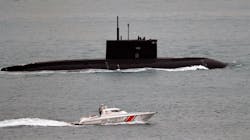Cold War-legacy Russian rocket-powered supercavitating torpedo development could yield deadly new results
MOSCOW – While a lull in great power competition delayed the impact of this new technology, the so-called supercavitating torpedo may be about to take the world by storm. The National Interest reports. Continue reading original article
The Military & Aerospace Electronics take:
6 Dec. 2019 -- One of the most innovative underwater weapons developed by the Soviet Union was the VA-111 Shkval (Squall) supercavitating torpedo.
Highly classified, Shkval was virtually unknown before the end of the Cold War and only became common knowledge in the mid-1990s. The rocket-powered torpedo was capable of astonishing speeds of up to 200 knots an hour. But in a world where physics ensured most ships and underwater weapons topped out at 50 knots, how did Russian engineers accomplish such a breakthrough in speed?
Traditionally, torpedoes use propellers or pumpjets for propulsion. Shkval, on the other hand, uses a rocket engine. That alone is enough to make it fast, but traveling through water creates major drag problems. The solution: get the water out of the path of the torpedo. But how, exactly does one get water of the path of an object in the middle of an ocean?
Related: Northrop Grumman team eyes developing technology for a 100-mile-per-hour submarine
John Keller, chief editor
Military & Aerospace Electronics
